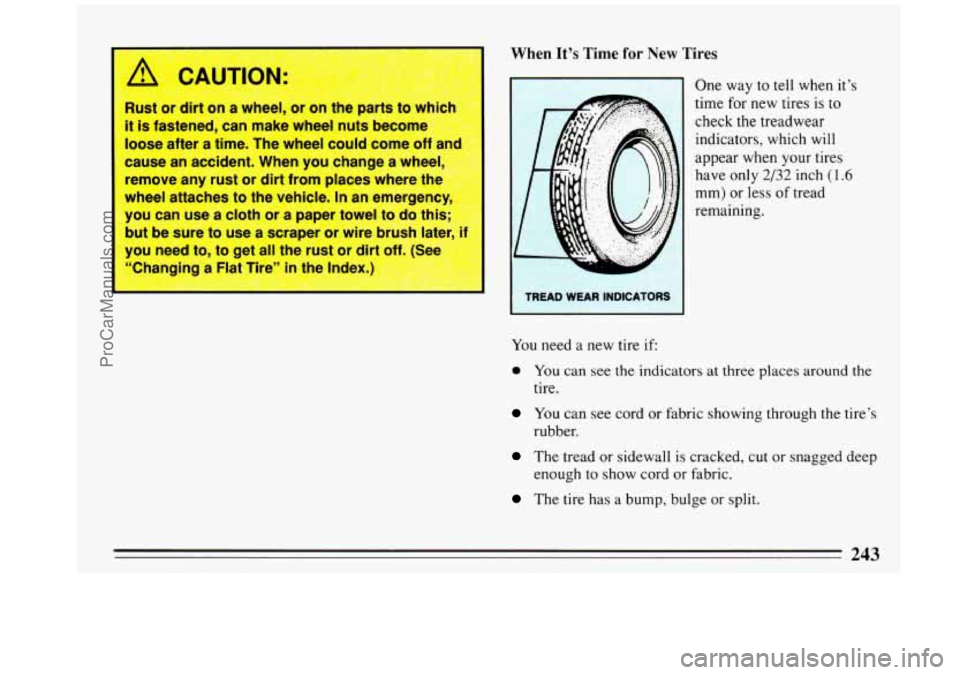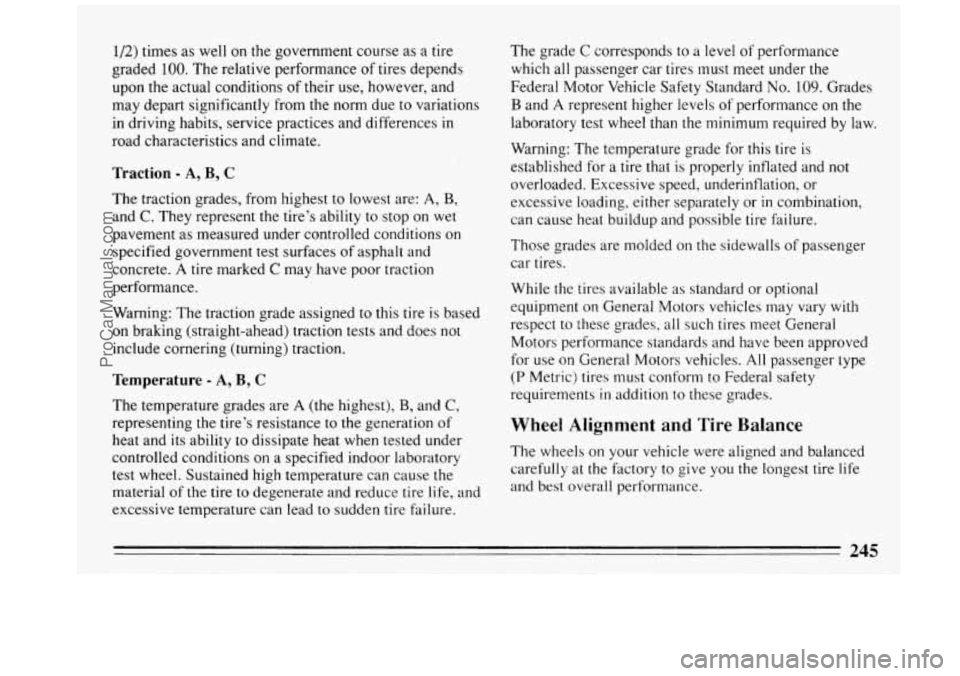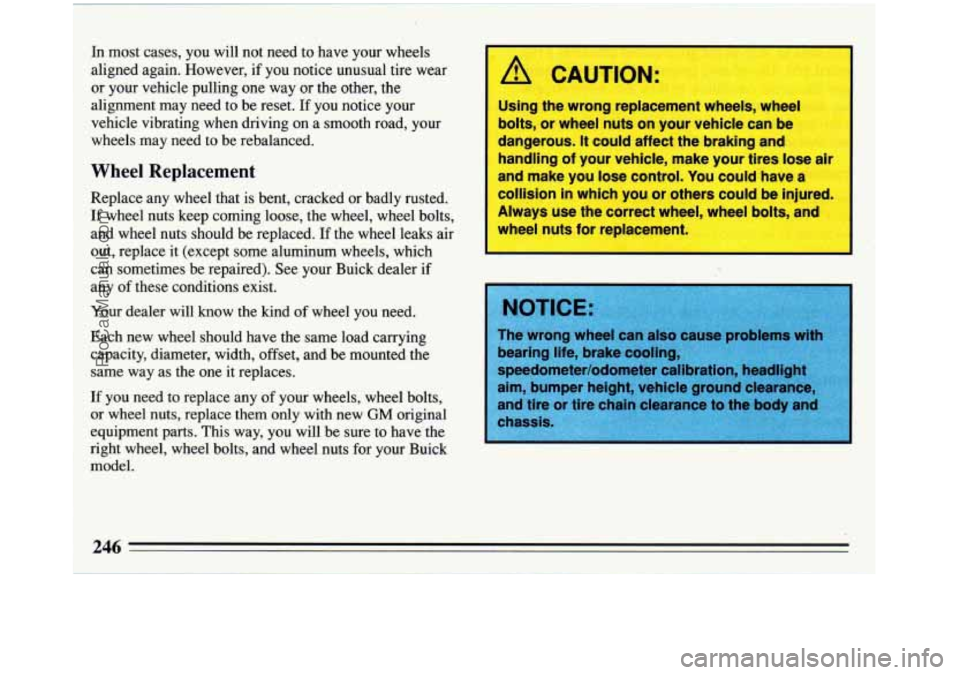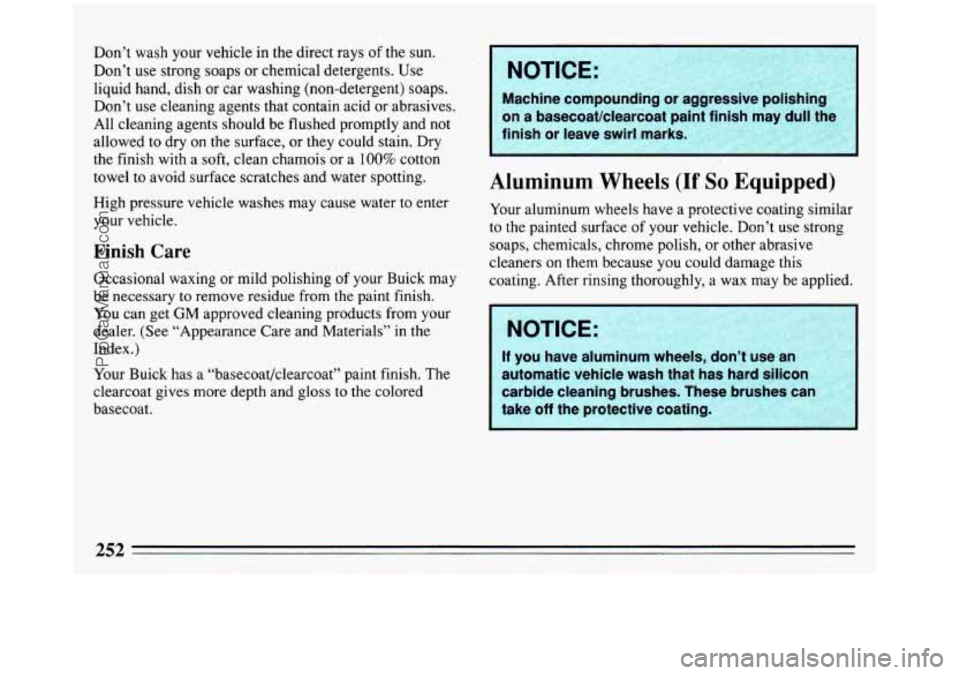Page 245 of 308

A CAW’ON
Rust or dirt on a wheel, or on the parts to which
it is fastened, can make wheel nuts become
loose after a time. The wheel could come off
a-”
cause an accident. When you change a wheel,
remove any rust or dirt from places where the
wheel attaches to the vehicle.
In an emergency,
you can use a cloth
or a paper towel to do this;
but be sure to use a scraper or wire brush later, if
you need to, to get all the rust or dirt off. (See
“nhanging a Flat
in the Index.)
I
When It’s Time for New Tires
b One wav to tell when it’s r’
time for new tires is to
check
the treadwear
indicators, which will
appear when your tires
have only
2/32 inch (1.6
mm) or less of tread
remaining.
I TREAD WEAR INDICATORS I
You need a new tire if
0 You can see the indicators at three places around the
tire.
You can see cord or fabric showing through the tire‘s
rubber.
The tread or sidewall is cracked, cut or snagged deep
enough to show cord or fabric.
The tire has a bump, bulge or split.
243
ProCarManuals.com
Page 247 of 308

1/2) times as well on the government course as a tire
graded
100. The relative performance of tires depends
upon the actual conditions of their use, however, and
may depart significantly from the norm due to variations
in driving habits, service practices and differences
in
road characteristics and climate.
Traction - A, B, C
The traction grades, from highest to lowest are: A, B,
and C. They represent the tire’s ability to stop on wet
pavement as measured under controlled conditions on
specified government test surfaces of asphalt and
concrete.
A tire marked C may have poor traction
performance.
Warning: The traction grade assigned to this tire
is based
on braking (straight-ahead) traction tests and does not
include cornering (turning) traction.
Temperature - A, B, C
The temperature grades are A (the highest), B, and C,
representing the tire’s resistance to the generation of
heat and its ability to dissipate heat when tested under
controlled conditions on a specified indoor laboratory
test wheel. Sustained high temperature can cause the
material
of the tire to degenerate and reduce tire life, and
excessive temperature can lead to sudden tire failure. The
grade
C corresponds to a level of performance
which all passenger car tires must meet under the
Federal Motor Vehicle Safety Standard
No. 109. Grades
B and A represent higher levels of performance on the
laboratory test wheel than the minimum required by law.
Warning: The temperature grade for this tire
is
established for a tire that is properly inflated and not
overloaded. Excessive speed, underinflation, or
excessive loading, either separately or
in combination,
can cause heat buildup and possible tire failure.
These grades are molded
on the sidewalls of passenger
car tires.
While the tires available
as standard or optional
equipment
on General Motors vehicles may vary with
respect to these grades, all such tires meet General
Motors performance standards and have been approved
for use on General Motors vehicles. All passenger type
(P Metric) tires must conform to Federal safety
requirements
in addition to these grades.
Wheel Alignment and Tire Balance
The wheels on your vehicle were aligned and balanced
carefully at the factory to give
you the longest tire life
and best overall performance.
245
ProCarManuals.com
Page 248 of 308

In most cases, you will not need to have your wheels
aligned again. However, if
you notice unusual tire wear
or your vehicle pulling one way or the other, the
alignment may need to be reset.
If you notice your
vehicle vibrating when driving on a smooth road, your
wheels may need to be rebalanced.
Wheel Replacement
Replace any wheel that is bent, cracked or badly rusted.
If wheel nuts keep coming loose, the wheel, wheel bolts,
and wheel nuts should be replaced. If the wheel leaks air
out, replace it (except some aluminum wheels, which
can sometimes be repaired). See your Buick dealer if
any
of these conditions exist.
Your dealer will know the kind of wheel you need.
Each new wheel should have the same load carrying
capacity, diameter, width, offset, and be mounted the
same way as the one it replaces.
If you need to replace any of your wheels, wheel bolts,
or wheel nuts, replace them only with new
GM original
equipment parts. This way, you will be sure to have the
right wheel, wheel bolts, and wheel nuts for your Buick
model.
A CAUTION:
Using the wrong replacement wheels, wheel
bolts, or wheel nuts on your vehicle can be
dangerous.
It could affect the braking and
handling of your vehicle, make your tires lose air
and make you lose control. You could have a
collision in which you or others could be injured.
Always use the correct wheel, wheel bolts, and
wheel nuts for replacement.
I I
1:-
ProCarManuals.com
Page 249 of 308
Used Replacement Wheels
A CAUTION:
Putting a used wheel on your vehicle is
dangerous. You can’t know how it’s been used or
how many miles it’s been driven.
It could fail
suddenly
and cause an accident. If you have to
equipment wheel.
~ replace a wheel use anew GM original
I
Tire Chains
If your Buick has P215160RI 6
tires, don’t us
your vehicle.
If you have other tires, use tire chains only when
you must. Use only
SAE Class “S” type chains
that are the proper size for your tires. Install
them on the front tires and tighten them as
tightly as possible with the ends securely
fastened. Drive slowly and follow the chain
manufacturer’s instructions.
If you can hear the
chains contacting your vehicle, stop and
retighten them.
If the contact continues, slow
down until it stops. Driving too fast with chains
on
will damage your vehicle.
ProCarManuals.com
Page 254 of 308

Don’t wash your vehicle in the direct rays of the sun.
Don’t
use strong soaps or chemical detergents. Use
liquid hand, dish or car washing (non-detergent) soaps.
Don’t use cleaning agents that contain acid or abrasives.
All cleaning agents should be flushed promptly and not
allowed
to dry on the surface, or they could stain. Dry
the finish with a soft, clean chamois or a
100% cotton
towel to avoid surface scratches and water spotting.
High pressure vehicle washes may cause water
to enter
your vehicle.
Finish Care
Occasional waxing or mild polishing of your Buick may
be necessary to remove residue from the paint finish.
You can get
GM approved cleaning products from your
dealer. (See “Appearance Care and Materials” in the
Index.)
Your Buick has a “basecoat/clearcoat” paint finish. The
clearcoat gives more depth and gloss to
the colored
basecoat.
I NOTICE: I
Machine compounding or aggressive polishing
on a basecoatlclearcoat pa
finish or leave swirl marks.
Aluminum Wheels (If So Equipped)
Your aluminum wheels have a protective coating similar
to the painted surface of your vehicle. Don’t use strong
soaps, chemicals, chrome polish, or other abrasive
cleaners
on them because you could damage this
coating. After rinsing thoroughly, a wax may be applied.
r
-
NOTICE:
6.
If you have aluminum wheels, don’t use an
j automatic vehicle wash that has hard silicon
’: carbide cleaning brushes. These brushes can
take
off the protective coating
252
ProCarManuals.com
Page 263 of 308
Regal Dimensions
Inches Unless Otherwise Noted
Overall: Coupe Sedan
Length ................... 193.6 193.9
Width
..................... 72.5 72.5
Height
.................... 53.0 54.5
Wheelbase
................ 107.5 107.5
Front Tread
................ 59.5 59.5
Rear Tread
................. 58.0 58.0
Interior Front:
Leg Room ................. 42.3
Head Room
................ 37.8
Shoulder Room
............. 57.6
Hip Room ................. 52.0 42.4
38.7
57.8
52.7
Interior Rear: Coupe
Leg Room ................. 34.8
Head Room
................ 37 . 1
Shoulder Room ............. 56.8
Hip Room ................. 53.1
Trunk Capacity . CU . Ft .... 15.6
Passengers:
Front ...................... 3
Rear
....................... 3
Base Curb Weight . Lbs ... 3152
Sedan
36.2
37.8
57.8
53.2
15.8
3
3
3236
. 261
ProCarManuals.com
Page 272 of 308
Scheduled Maintenance Services Schedule I
Follow Schedule I if your car is MAINLY driven under one or more of the following conditions: I
0 When most trips are less than 4 miles (6 kilometers).
0 When most trips are less than 10 miles (16 kilometers) and outside temperatures remain below freezing.
0 When most trips include extended idling and/or frequent low-speed operation as in stop-and-go traffic.
0 Towing a trailer.*?
When operating in dusty areas.
Schedule I should also be followed if the car is used for delivery service, police, taxi or other commercial applications.
TO BE SERVICED
(See Explanation of
Scheduled Maintenance
Services Following Schedules
I and 11)
Item No.
1. Engine Oil & Oil Filter
Change*
2. Chassis Lubrication
3. Throttle Body Mounting Bolt Torque*
4. Tire & Wheel Inspection &
Rotation
5. Engine Accessory Drive
' Belt(s) Inspection*
6. Cooling System Service*
65 70 75 80
0.00
0 0
270
ProCarManuals.com
Page 274 of 308
Scheduled Maintenance Services Schedule I1
IIONLY if none of the driving conditions specified in Schedule I apply.
TO BE SERVICED
(See Explanation of
Scheduled Maintenance
Services Following Schedules
I and 11)
Item No.
1. Engine Oil Change*
Oil Filter Change*
2. Chassis Lubrication
3. Throttle Body Mounting Bolt Torque*
4. Tire & Wheel Inspection & Rotation
5. Engine Accessory Drive Belt(s) Inspection*
6. Cooling System Service*
WHEN TO PERFORM
Miles (kilometers)
or
Months, Whichever
Occurs First
I MILES (000)
lm
KILOMETERS (
Every 7 500 mi. (12 500 km) or 12 mos. 1~101010 ~~
At first and then every other oil change
Every
7 500 mi. (12 500 km) or 12 mos.
At 7 500 mi. (12 SO0 km) only
At
7 500 mi. (12 SO0 km) and then every
15 000 mi. (25 000 km) or as necessary 1.1 1.1
I I I 0 Every 30 000 mi. (SO 000 km) or 24 mos. I I I
I I I 0
+
272
ProCarManuals.com